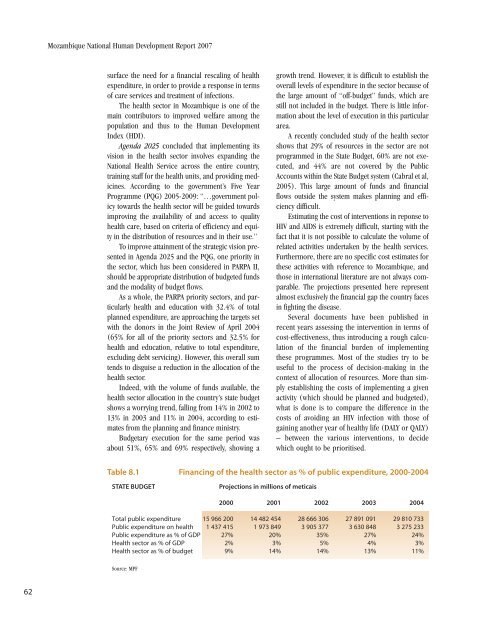English language version - Human Development Reports - United ...
English language version - Human Development Reports - United ...
English language version - Human Development Reports - United ...
- No tags were found...
You also want an ePaper? Increase the reach of your titles
YUMPU automatically turns print PDFs into web optimized ePapers that Google loves.
Mozambique National <strong>Human</strong> <strong>Development</strong> Report 2007surface the need for a financial rescaling of healthexpenditure, in order to provide a response in termsof care services and treatment of infections.The health sector in Mozambique is one of themain contributors to improved welfare among thepopulation and thus to the <strong>Human</strong> <strong>Development</strong>Index (HDI).Agenda 2025 concluded that implementing itsvision in the health sector involves expanding theNational Health Service across the entire country,training staff for the health units, and providing medicines.According to the government’s Five YearProgramme (PQG) 2005-2009: “…government policytowards the health sector will be guided towardsimproving the availability of and access to qualityhealth care, based on criteria of efficiency and equityin the distribution of resources and in their use.”To improve attainment of the strategic vision presentedin Agenda 2025 and the PQG, one priority inthe sector, which has been considered in PARPA II,should be appropriate distribution of budgeted fundsand the modality of budget flows.As a whole, the PARPA priority sectors, and particularlyhealth and education with 32.4% of totalplanned expenditure, are approaching the targets setwith the donors in the Joint Review of April 2004(65% for all of the priority sectors and 32.5% forhealth and education, relative to total expenditure,excluding debt servicing). However, this overall sumtends to disguise a reduction in the allocation of thehealth sector.Indeed, with the volume of funds available, thehealth sector allocation in the country’s state budgetshows a worrying trend, falling from 14% in 2002 to13% in 2003 and 11% in 2004, according to estimatesfrom the planning and finance ministry.Budgetary execution for the same period wasabout 51%, 65% and 69% respectively, showing agrowth trend. However, it is difficult to establish theoverall levels of expenditure in the sector because ofthe large amount of “off-budget” funds, which arestill not included in the budget. There is little informationabout the level of execution in this particulararea.A recently concluded study of the health sectorshows that 29% of resources in the sector are notprogrammed in the State Budget, 60% are not executed,and 44% are not covered by the PublicAccounts within the State Budget system (Cabral et al,2005). This large amount of funds and financialflows outside the system makes planning and efficiencydifficult.Estimating the cost of interventions in reponse toHIV and AIDS is extremely difficult, starting with thefact that it is not possible to calculate the volume ofrelated activities undertaken by the health services.Furthermore, there are no specific cost estimates forthese activities with reference to Mozambique, andthose in international literature are not always comparable.The projections presented here representalmost exclusively the financial gap the country facesin fighting the disease.Several documents have been published inrecent years assessing the intervention in terms ofcost-effectiveness, thus introducing a rough calculationof the financial burden of implementingthese programmes. Most of the studies try to beuseful to the process of decision-making in thecontext of allocation of resources. More than simplyestablishing the costs of implementing a givenactivity (which should be planned and budgeted),what is done is to compare the difference in thecosts of avoiding an HIV infection with those ofgaining another year of healthy life (DALY or QALY)– between the various interventions, to decidewhich ought to be prioritised.Table 8.1 Financing of the health sector as % of public expenditure, 2000-2004STATE BUDGETProjections in millions of meticais2000 2001 2002 2003 2004Total public expenditure 15 966 200 14 482 454 28 666 306 27 891 091 29 810 733Public expenditure on health 1 437 415 1 973 849 3 905 377 3 630 848 3 275 233Public expenditure as % of GDP 27% 20% 35% 27% 24%Health sector as % of GDP 2% 3% 5% 4% 3%Health sector as % of budget 9% 14% 14% 13% 11%Source: MPF62
















